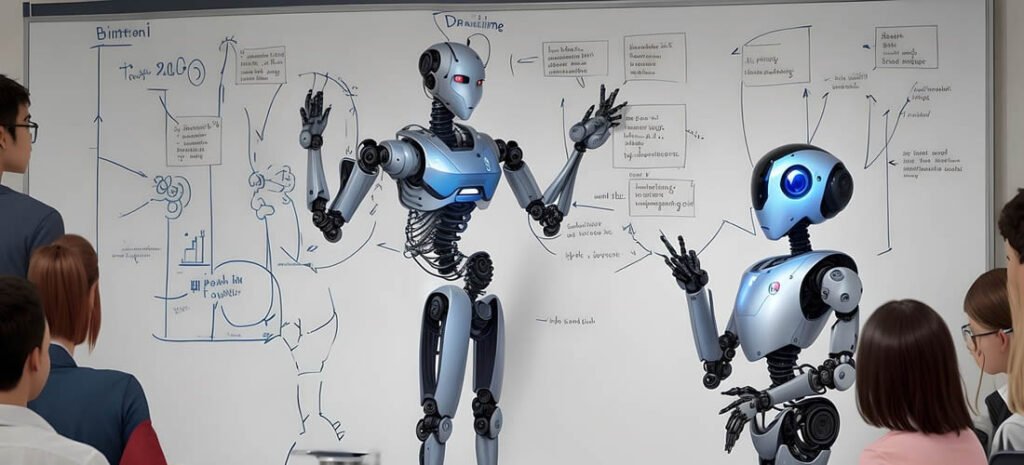Do you ever feel like you don’t have enough time in your busy day to learn new skills or brush up on topics you want to master? Do lengthy online courses make your eyes glaze over? Well, I’ve got good news for you – there’s a better way to learn that works with your lifestyle. Let me introduce you to the power of microlearning.
Microlearning is exactly what it sounds like – learning through bite-sized lessons that distill key concepts into small, highly-focused chunks. We’re talking 5-10 minute sessions, not 5-10 hour ones. These short bursts of learning have some major advantages that make getting smarter way more convenient.
With microlearning, you can gain knowledge on the go, whenever you have a few spare minutes. Waiting for your coffee to brew? Knock out a quick lesson. Standing in line at the store? Pull out your phone and learn something new. Microlearning fits seamlessly into the nooks and crannies of your daily routine. And because the lessons are so short and engaging, you’ll actually look forward to learning!
The focused nature of microlearning also means the knowledge sticks better. No more mind-numbing info overload from hours-long training. These condensed sessions isolate key ideas and concepts so they can really sink in. You’ll retain more in less time.
Let’s explore some more reasons microlearning works so well.
Benefits of Microlearning
1. Improved retention and memory
Our brains are wired to absorb information in small, digestible bits. When learning materials are broken down into short, focused lessons, it becomes easier for you to grasp and retain the information. It’s less overwhelming, and it allows you to engage more intensively with what you’re learning. Plus, think about it: Shorter lessons mean you’re more likely to remember what you’ve learned, simply because there’s less to forget! In essence, microlearning is playing right into your brain’s strengths, making learning more efficient and less of a memory test.
2. Just-in-time access to knowledge
Imagine you’re in the middle of a task and you run into a problem. Instead of having to scour through an entire manual or sit through a lengthy course, microlearning enables you to access the precise piece of information you need right then and there. It’s like having a bite-sized tutorial at your fingertips, tailored to give you the specific knowledge you need at the moment. This immediacy not only saves time, but it also enhances your productivity and effectiveness.
3. Increased engagement
Microlearning works wonders in increasing engagement. You see, its bite-sized modules are designed to meet your short attention span. These concise courses, generally ranging from 3 to 5 minutes, make it easier for you to grasp and retain information. Instead of slogging through hours of lecture material, you can enjoy learning in quick, manageable chunks. Plus, the flexibility of microlearning allows you to learn at your own pace and on your own schedule, making the whole process less intimidating and more engaging.
4. Convenient and accessible
Microlearning makes education a breeze by breaking down complex concepts into digestible chunks. One of the biggest advantages you’ll experience is its convenience and accessibility. Picture this – you’re on a crowded train during your daily commute, instead of aimlessly scrolling through social media, you decide to learn something new. With microlearning, you can utilize this time effectively and access learning modules right from your smartphone. The short, focused nature of these modules allows you to make progress without needing large blocks of time. This means you can educate yourself at your own pace, on your terms, and in any setting. Learning has never been so easy and flexible!
5. Lower training costs
With microlearning, you’re able to lower your training costs significantly. Traditional training methods often involve extensive resources, including trainers’ time, travel expenses, and physical materials. In contrast, microlearning breaks down complex concepts into bite-sized, manageable chunks that can be delivered digitally. This not only reduces the need for physical resources but also allows for self-paced learning, driving efficiency and cutting costs. Furthermore, it’s easier and less costly to update digital microlearning modules as required, ensuring your training content remains relevant and effective without breaking the bank.
6. Applicability to varied learning styles
Microlearning is a real game-changer for people with diverse learning styles. Whether you’re a visual learner who grasps information better through images and diagrams, an auditory learner who prefers listening to podcasts, or a kinesthetic learner who learns best by doing, microlearning has got you covered. It offers bite-sized learning modules that can be delivered in a variety of formats, such as video, audio, interactive quizzes, or even virtual reality experiences. This means you can choose the format that suits your learning style the best, making learning not just effective, but also enjoyable!
7. Easier to update content
With microlearning, updating your content becomes a breeze. Imagine having to sift through a lengthy, detailed course every time new information emerges or a process changes. Sounds daunting, right? However, in a microlearning scenario, your learning material is already broken down into bite-sized pieces, making it remarkably easier to locate and update the necessary sections. You can quickly adapt to changes and ensure your content remains current and relevant, significantly enhancing the learning experience for your audience.
8. Supports spaced repetition
With microlearning, you can benefit significantly from the concept of spaced repetition. This learning strategy involves reviewing the information at increasing intervals over a certain period, which is extremely effective in transferring knowledge from your short-term memory to your long-term memory. So, instead of cramming all information in one go, you’ll be revisiting the concepts in bite-sized, manageable chunks, reinforcing your learning and making it stick. This way, you’re not just learning better, but you’re also enjoying the process without feeling overwhelmed.
9. Easier to track progress
Microlearning makes tracking your progress a breeze. Imagine this, instead of having to complete a lengthy course before you can see your results, each bite-size module you finish gives you instant feedback. This allows you to monitor your progress continually, understand the areas you’re excelling in and those you need to devote more time to. It’s like having a personal route map for your learning journey, ensuring you’re never lost and always know how far you’ve come and how far you have to go.
Strategies for Designing Effective Microlearning Modules
- Keep it short – Limit modules to 5-10 minutes. Stick to one clear learning objective. Avoid information overload.
- Make it visual – Incorporate eye-catching images, illustrations, infographics, video clips. Cater to visual learners.
- Add interactivity – Include questions, quizzes, prompts, drag-and-drop activities. Promote active learning.
- Personalize content – Tailor modules to the learner’s knowledge gaps, interests, goals. Increase relevance.
- Provide feedback – Give timely praise, correction, assessment via the module. Reinforce key learnings.
- Facilitate sharing – Allow easy sharing via social media, email etc. Encourage peer learning.
- Use varied formats – Combine different formats like video, audio, text, images. Accommodate different learning preferences.
- Implement spaced repetition – Reinforce concepts through multiple, spaced out modules for better recall.
- Make it mobile-friendly – Optimize modules for learning on the go via mobile devices. Enhance accessibility.
- Track progress – Include module completion status, knowledge checks, impact metrics. Monitor learning.
Tips for Implementing Microlearning Successfully
Here are some tips for integrating microlearning into educational/training programs and selecting the right technology:
Integrating Microlearning
- Start small – Run pilots to get buy-in before scaling program-wide. Rather than overhauling your entire curriculum, begin by transforming just one lesson or module into bite-sized, easily digestible mini-lessons. Each mini-lesson should be focused on a single objective or skill. As you observe the effectiveness of these mini-lessons, you can then incorporate more microlearning techniques into your program, tailoring them to suit the specific needs of your learners.
- Set clear objectives – Align microlearning goals to specific skills/knowledge gaps learners need to fill. This means you need to identify what your learners should know or be able to do at the end of the microlearning module. Microlearning is all about delivering bite-sized, focused content, so your objectives should be equally focused and concise.
- Provide learner guidance – Give recommendations on module sequence, frequency, and scenarios to utilize lessons. Keep your microlearning modules succinct and focused. This makes it easy for learners to digest information and engage with the content. Provide clear instructions and objectives at the beginning of each module, so learners know exactly what they’re expected to learn.
- Blend with other methods – Use microlearning to supplement, not replace, larger courses and programs. Try to integrate microlearning with traditional learning methods, like lectures or workshops. You can use microlearning modules as pre-work to introduce a new concept before a lecture, or as post-work to reinforce the knowledge learned. Similarly, blending microlearning with practical application methods like project-based learning can provide a theoretical foundation before learners dive into projects, or a reflective tool after completing them.
- Reinforce through practice – Microlearning modules are designed to be short and focused, allowing you to quickly grasp a concept. However, it’s the repetition and application that truly cements this knowledge. When you’ve completed a microlearning module, don’t just move on to the next one. Instead, take a moment to apply what you’ve learned in a real-world context.
- Incentivize participation – Consider implementing a points or badge system to recognize the effort and progress of your learners. You can try gamification to transform learning into a game. The competitive spirit can drive engagement and increase participation rates. Leaderboards, quizzes, and time-bound challenges are great ways to introduce gamification.
- Evaluate regularly – You may use surveys, quizzes, and direct feedback to gauge learner experience and measure knowledge retention. The beauty of microlearning is that it allows for quick iterations. If something isn’t working, you can tweak and adjust your content based on the insights gained from these evaluations.
Selecting Technology
- Prioritize mobile capability – Enable accessible learning across devices, especially smartphones. Consider platforms that are responsive, easy-to-navigate on a mobile screen, and offer offline access. Ensure your microlearning content is designed for mobile use, with a simple, clear layout and multimedia that loads quickly.
- Consider creation tools – Pick tools that make it easy for non-technical folks to create microcontent. Look for tools that allow for easy content creation and modification. Consider a platform that supports short, bite-sized content formats.
- Support multi-format – Look for a tool that can handle text, images, audio, video, and interactive elements. This way, you can deliver your microlearning modules in diverse formats, catering to a wide range of learning styles. Mix things up with videos, podcasts, interactive content beyond just text/images.
- Provide personalization – Look for adaptive learning features to tailor lessons to individual learners. By leveraging technology that offers adaptive learning features, you can ensure that content is delivered in bite-sized chunks, catering to the unique learning styles of each individual.
- Integrate with LMS – Select systems that integrate with your learning management system for unified tracking. You should look for a tool that can synchronize with your LMS to provide consolidated reports for better decision-making. Also, if your chosen microlearning tools align well with your existing LMS, it will be easier for learners to navigate, access content, and complete their learning tasks.
- Analyze usage – Leverage platforms that offer robust analytics on engagement, completion, effectiveness. This functionality empowers you to monitor learners’ interaction with the material, track their progress, and identify areas of improvement. The tool should provide you with insights into which content pieces are most and least effective, based on user engagement and feedback.
- Assess scalability needs – Factor in the number of learners and modules needed now and in future. You want a technology that can handle this growth without compromising the quality of education. Look for a platform that’s easy to maintain and upgrade. It’s also important to consider a platform that can integrate with other systems, ensuring seamless delivery of microlearning modules.
Real-World Examples
- Walmart – Rolled out microlearning modules via a mobile app to train over 1 million customer service employees on soft skills like empathy, problem-solving, and communication.
- Lowes – Created 3-5 minute video lessons for employees to learn procedures, products, and customer interactions on demand from mobile devices.
- Harvard – Uses the spaced repetition app Anki to reinforce key concepts through flashcards across medicine, law, and business programs.
- Duolingo – This popular language learning app uses bite-sized lessons and gamification to engage over 500 million learners worldwide.
- Google – Employees use SmartUp app to choose microlessons and courses on leadership, productivity, and other topics to fit their schedules.
- Swiss Re – Insurance firm reduced training time by 40% using microlearning modules focused on specific business processes and scenarios.
- University of Michigan – Microlectures supplement lectures with 3-5 minute videos on key concepts across disciplines like physics and accounting.
- Flipkart – India’s largest e-commerce company sends 5-minute audio lessons daily to new hires’ mobiles during onboarding.
- Novartis – Pharmaceutical firm shares 2-3 minute new drug launch videos with sales reps on tablets instead of large meetings.
Conclusion
Microlearning may be small, but the benefits are big. Now you know that properly designed microlearning modules can pack a serious punch when it comes to boosting your knowledge. These bite-sized lessons are convenient to fit into busy schedules, simple to absorb and recall, and stimulate better overall learning habits.
Major companies around the world are catching on to the power of microlearning to engage employees and improve performance. But you don’t have to wait for it to come from your workplace. Start integrating microlearning into your day on your own terms to become a lifelong learner.
With just a few minutes here and there, you can master new skills, expand your knowledge, and achieve your goals more efficiently. Approach microlearning with clear objectives, consistent practice, and an open mind. Soon, you’ll start noticing improvements in your confidence and competence.
So grab your smartphone and get started on your microlearning journey. The knowledge you gain in short spurts will stack up over time into something great. When you commit to microlearning, you commit to never stop growing. And that’s an investment that will pay off for years to come.
You might also like:
- Technology and Memory: The Impact on Learning
- 9 Powerful Ways to Harness Robotics for Hands-On Learning
- 13 Effective Note-Taking Strategies for Learning Success
- 13 Alternative Learning Methods for Effective Learning


